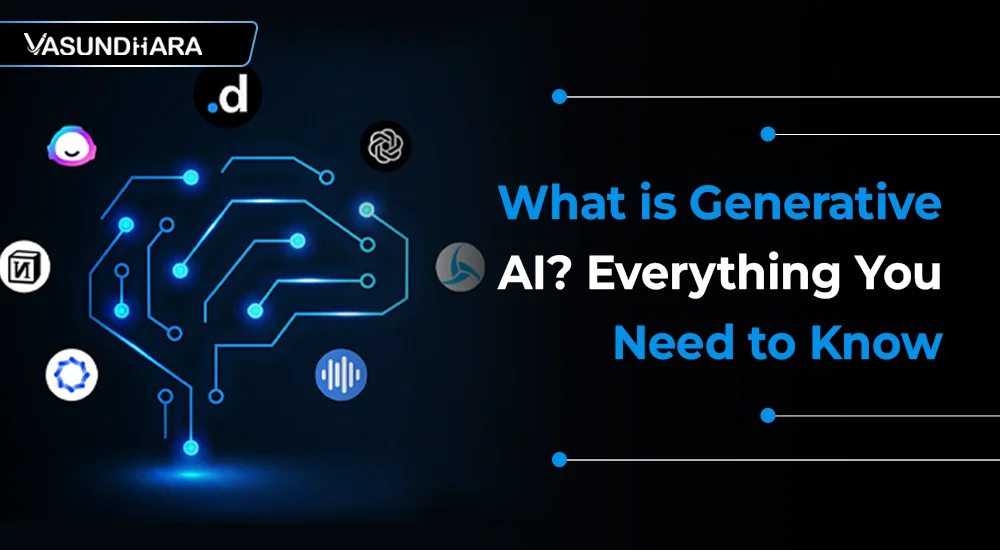What is Generative AI? Everything You Need to Know


- Apr 3, 2024
Generative AI is a significant development in artificial intelligence that brings about a revolutionary change in human-machine interactions. It enables AI systems to demonstrate intelligence, empathy, and creativity at a level comparable to humans. Generative artificial intelligence surpasses the constraints of rule-based instruction by producing contextually aware solutions in the form of written content, visuals, and even intricate software codes.
This blog aims to provide a comprehensive overview of the basic principles of generative artificial intelligence, what is Generative AI, how does it work, types, applications, advantages, limitations and its impact on the future of technology and business solutions.
Generative AI refers to a certain kind of artificial intelligence system that has the ability to produce text, images, or other forms of media in response to given stimuli.
Typically, individuals input a command or query into a generative AI platform or tool and promptly receive a highly appropriate response, creating a conversational experience. It is motivating organizations to explore conversational commerce solutions in order to enhance online personalization to a higher degree.
Generative AI is a branch of artificial intelligence that aims to replicate the creative and productive abilities of humans. Generative AI is supposed to operate independently and innovate without extensive human guidance, rather than receiving detailed instructions at every stage. Generative AI algorithms are trained on extensive datasets and have the ability to generate novel outputs based on the knowledge they have been provided.
Generative Artificial Intelligence uses advanced machine learning techniques to create fresh, realistic material. Its capability is based on several models and frameworks, including Generative Adversarial Networks (GANs), Transformers, and Recurrent Neural Networks.
Generative AI models are trained using big datasets. These datasets can contain text, photos, audio, or any other sort of material that the model is intended to generate. The training data provides the model's starting point for learning patterns, structures, and features.
GANs are a widely used architecture for generative AI. GANs are made up of two neural networks: a generator and a discriminator, which are trained simultaneously. The generator creates new data instances, while the discriminator compares the created data against real data.
RNNs are a sort of neural network that uses recurrent connections to transmit information from one phase to the next. While less frequent in recent generative AI breakthroughs, RNNs are still utilized in some situations, particularly for sequential data generation.
There are numerous types of generated AI models, but the following are among the most prevalent:
GANs comprise two neural networks—a discriminator and a generator. The generator produces fresh content, whereas the discriminator is designed to differentiate between authentic and generated material. Competition-based training of the discriminator and generator enhances the quality of the generated content.
Diffusion models are generative AI models that progressively introduce noise to an image and then remove it. Using diffusion models, new images can be generated or existing ones modified.
Transformer models are an especially well-suited neural network architecture for text generation. Transformer models have been employed in developing GPT-3 and Bard, two of the most potent language models.
Numerous potential uses for generative AI exist, and new uses are always being found. To know how to use Generative AI, check out the following:
Generative AI produces new and inventive art and design. For instance, artists use generative AI to produce novel painting and sculpture techniques, and designers use it to create new goods and services.
Generative AI produces original video and music. For instance, musicians use generative AI to write original songs and produce music videos. Filmmakers are developing new special effects and visual effects with generative AI.
New, more engaging video games being created with the help of generative AI. For instance, game makers use generative AI to produce realistic characters and environments.
Scientific research is being accelerated by the usage of generative AI. For instance, generative AI is used by scientists to create new materials and find new medicine prospects.
Generative AI is a subset of artificial intelligence. Understanding the differences between these technologies can offer significant insights into their varied capabilities and uses.
Traditional AI, also called narrow or weak AI, follows set rules and algorithms to complete jobs. A single action or a small group of tasks are what it's made to do very well.
Google Search, systems that recognize faces and images, and recommendation engines like Netflix and Amazon are all examples of traditional AI uses.
This type of artificial intelligence permits machines to interact with humans via natural language. Conversational AI applications utilize natural language understanding (NLU) to decipher spoken or written language and generate responses that emulate conversations. Consider language translation services, conversational assistants such as Siri and Alexa, and customer support chatbots.
Adaptive AI systems, also known as learning AI systems, are capable of adjusting to shifting environments. They are powered by a variety of AI technologies, such as reinforcement learning, evolutionary algorithms, and machine learning. They can alter their conduct and enhance their performance gradually by perpetually gaining knowledge from new information and feedback.
Illustrative cases include intelligent healthcare systems that enable clinicians to personalize treatment plans, credit card fraud detection systems, and tools designed to forecast machine maintenance in industrial environments.
Generative AI, particularly in the form of Generative Adversarial Networks (GANs) and other models like Variational Autoencoders (VAEs), has gained significant attention in recent years due to its ability to generate realistic data, images, text, and even audio. Here are some of the advantages and limitations of generative AI:
Generative AI can create synthetic data that closely resembles real data. This is particularly useful in scenarios where collecting real data is expensive, time-consuming, or limited.
Generative AI can be used to generate creative content such as images, music, and literature. This has applications in art, entertainment, and design fields
Generated data can be used to augment existing datasets, thereby improving the performance of machine learning models, especially in scenarios with limited labeled data.
Generative models can be used to detect anomalies by identifying data points that deviate significantly from the generated distribution. This is useful in fraud detection, cybersecurity, and quality control.
Generative AI can be used to create personalized content or recommendations based on user preferences and behaviors.
Imagination and Exploration: Generative models can be used to explore new possibilities and generate novel ideas, aiding in research and innovation.
Training generative models can be computationally expensive and requires large amounts of data. Tuning the parameters and architecture of the model can also be challenging.
Generative models, particularly GANs, may suffer from mode collapse, where the generator fails to capture the entire distribution of the data, leading to generated samples that lack diversity.
Assessing the quality of generated samples is subjective and often relies on human judgment. Developing objective evaluation metrics for generative models remains an open research problem.
Generated content can be used for malicious purposes, such as creating fake news, deepfakes, or other forms of misinformation. This raises ethical concerns about the responsible use of generative AI technology.
Generative models may inherit biases present in the training data, leading to biased or unfair generated content. Careful preprocessing of training data and evaluation of model outputs are necessary to address these issues.
Generative models may be vulnerable to adversarial attacks, where small perturbations to the input data result in significant changes to the generated output. Ensuring robustness against such attacks is a challenging problem.
Overall, while generative AI holds great promise in various applications, addressing its limitations and ensuring responsible deployment are essential for realizing its full potential.
The future of Generative AI holds promise across various domains. Enhanced models will seamlessly produce high-fidelity text, images, and even code, revolutionizing content creation, design, and programming. Ethical considerations regarding misuse and bias mitigation will be paramount, driving research into transparent and accountable AI systems. Collaboration between AI and human creators will flourish, augmenting creativity and productivity.
Generative AI's potential extends to personalized healthcare, generating tailored treatments and diagnoses. As technology advances, challenges such as data privacy and AI-generated misinformation will necessitate robust regulatory frameworks. Ultimately, Generative AI stands poised to shape a future where creativity and innovation know no bounds.
Generative AI is fast evolving, and new applications are continually emerging. As generative AI models become more powerful and sophisticated, they will be used in various applications.
For example, generative AI might provide personalized educational experiences for students or generate innovative medical therapies for patients. It may also potentially be utilized to develop new types of entertainment and art.
The possibilities are boundless, and we're thrilled to see how generative AI will affect the future. Our professionals at Vasundhara Infotech specialize in all aspects of latest technologies. If you require any services for website and app development, or other purposes, please contact us. We have a team of professionals ready to assist your business expand massively in every manner.
Please follow us on all social media platforms, including LinkedIn, Instagram, and Facebook, to stay up to date on the latest technologies and trends.
Copyright © 2025 Vasundhara Infotech. All Rights Reserved.
